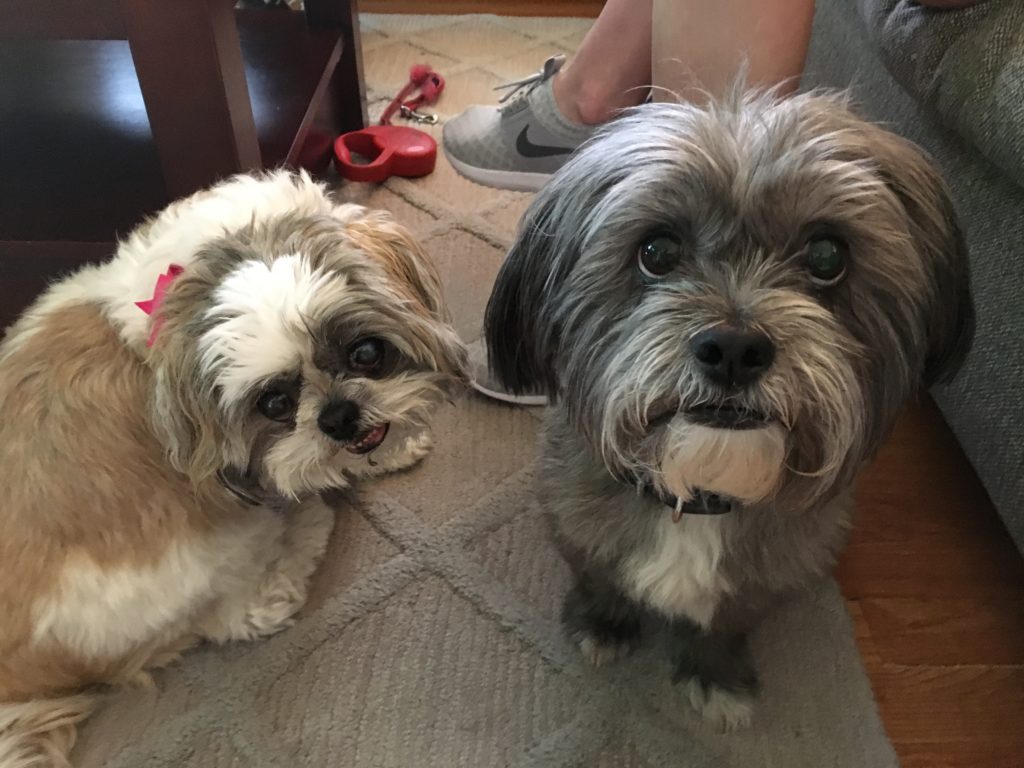Helping a Pair of Shih Tzu’s Learn to Follow Their Guardian’s Lead
By: David Codr
Published Date: June 15, 2016
Ellie is a twelve-year-old Shih Tzu who lives with Rocky, a six-year-old Shih Tzu / Silky terrier mix. Ellie is protective of one of her guardians, especially to her spouse. Rocky likes to jumps up on the door, pulls on the leash and is reactive to dogs, bicycles, skateboards – basically anything moving quickly.
Rocky showed good curiosity, meeting me at the door while doing a little barking. On the other hand Ellie stayed away and barked quite a bit until we sat down. Due to a few knee and elbow issues, her guardian picked her up and placed the dog at her side on the couch. As soon as Rocky saw this, he jumped up on the couch, then jumped up on the cushion on the back. This was my first indication that a lack of structure may be impacting the dog’s behavior.
Adding rules, boundaries and limits can help the dogs start to see and identify the humans as being authority figures. This will be an important transition the guardians will need to achieve to truly put a stop to their dog’s problems. If a dog considers itself to have the same rank or authority as its humans, then listening to the humans becomes optional.
Each time the dog’s guardians correct the dogs to enforce these new rules and boundaries (within seconds of the dog breaking the rule), the dogs will gain some respect for them as authority figures. Over time, the rules and actions of the guardians will redefine the leader follower dynamic so that the dogs listen to and obey the guardians the first time.
Another great way to help the dog’s transition into a follower mindset is to ask it to do something before they pet their dogs. This use of positive reinforcement can really help motivate a dog to please it humans. I call this technique Petting with a Purpose.
It will take the guardians a few days to get into the habit of only petting the dogs after they follow a command, but once they do they will basically be engaging in a mini dog obedience training session each time they do.
Now that we had introduced ways to reward positive behaviors, I spent the next few minutes sharing a set of escalating consequences I developed to disagree with unwanted actions or behaviors. Because I developed these from my observation of how dogs interact with one another, most dogs understand and respect them immediately.
We put the escalating consequences to the test when I had one of the guardians go out and play the part of a guest knocking at the door.
By controlling the doorway and making the dog back up behind a preset boundary before opening the door, I was able to get Rocky to settle down considerably. The additional distance also helps the arriving guest be less intense to the dog which makes it easier for them to remain calm.
Another great way to develop a healthy leader follower dynamic is to practice what I refer to as a Structured Walk. This involves the dog walking at a heel next to his or her handler and paying attention while following their lead.
Because Rocky got over excited during the leashing process I showed his guardians how to get him to settle down before attaching the leash. A dog’s energy inside before a walk is usually the energy level they will carry with them outside.
Once Rocky was able to stay calm throughout the leashing process, I offered his guardian some rules for a walk and showed her how to correct with the leash rather than using it to pull the dog into position. I always like to get the dog to do the work as that leads to a lifetime of adopting the desired behavior.
It will take some practice at the structured walk before the new technique, position and corrections become second nature to Rocky’s guardian. But once that is the case, he will start to literally follow her. For dogs, being in front is the leadership position so leash training like this will go a long ways towards developing Rocky’s obedience too.
We finished up the session by adding some structure and discipline to the feeding ritual. Because dogs place such a high value on eating, controlling access will be a small thing to the humans but the impact on the dog’s should be considerable.
By the end of the session, Rocky was staying 20 feet from the door and not barking at all as we practice knocking at the door. He was showing respect for personal space, sitting to ask for attention and even respecting the new rules on his own. It will be important for his guardians to consistently enforce the rules and correct or reward with good timing for the dogs to start to adjust into a follower’s mindset. But once they do, it will be easy for the guardians to communicate that they disagree in a way the dogs recognize and respond to.
Categorized in: Dog Behavior




